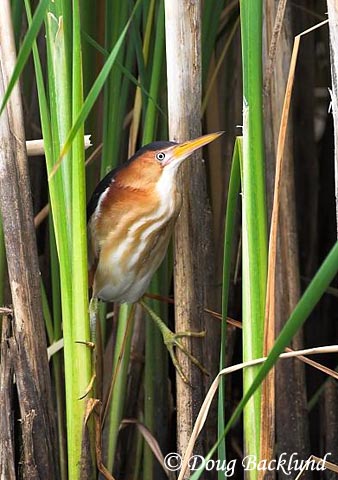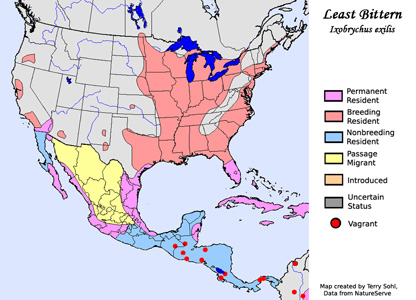Least Bittern
Ixobrychus exilis
| Length: 13 inches | Wingspan: 18 inches | Seasonality: Summer / Migrant |
| ID Keys: Dark back and tail, white underparts with buffy streaks, buff head and neck, black crown. | ||
 A shy, secretive bird of dense weedy marshes and sloughs, and
one of the smallest of the world's herons. Rather than wading like most of the
herons, the Least Bittern uses its long toes to clamber around emergent wetland
vegetation, just above the water's surface. The Least Bittern is one of
multiple similar species to "freeze" when startled, raising its head
and swaying back and forth in an attempt to blend in with the swaying marsh
vegetation.
A shy, secretive bird of dense weedy marshes and sloughs, and
one of the smallest of the world's herons. Rather than wading like most of the
herons, the Least Bittern uses its long toes to clamber around emergent wetland
vegetation, just above the water's surface. The Least Bittern is one of
multiple similar species to "freeze" when startled, raising its head
and swaying back and forth in an attempt to blend in with the swaying marsh
vegetation.
Habitat: Freshwater marshes and sloughs with dense emergent wetland vegetation.
Diet: Mostly small fish and large insects. Also crustaceans, amphibians, small rodents, and small snakes.
Behavior: Least Bitterns cling to vegetation stems with their feet, staying just above the water's surface, searching for prey and thrusting the bill downwards to grab prey items when spotted.
Nesting: June and July
Song: Least Bittern Song, also Least Bittern Call
Migration: Summers throughout most the eastern U.S. and in scattered locations in the West. Winters in the extreme southern U.S., Mexico, and Central America.
Interactive eBird map: Click here to access an interactive eBird map of Least Bittern sightings
Similar Species: Green Heron
Conservation Status: In decline in some areas due to habitat loss and pesticide runoff.
Further Information: 1) USGS Patuxent Bird Identification InfoCenter, Least Bittern
2) Audubon Guide - Least Bittern
3) Whatbird.com: Least Bittern
Photo Information: Photo taken near Pierre by Doug Backlund
| Click on the map below for a higher-resolution view |
 |
| South Dakota Status: Uncommon summer breeding resident and migrant in the east. Rare in the west. |
Additional Least Bittern Photos (coming soon!)
